Nail psoriasis belongs to one of the varieties of the disease, which mainly affects the skin. Like other types of pathology, this form has a chronic non-infectious course of a recurrent nature. The main signs of damage to the nail plates from psoriasis are a change in their shape, loss of shine, the appearance of spots on the plate, as well as the complete detachment of the nail.
With this shape, the skin around the plate also suffers. Inopportune and incorrect treatment can lead to complications such as severe deformities and total loss of nails in the hands and feet.
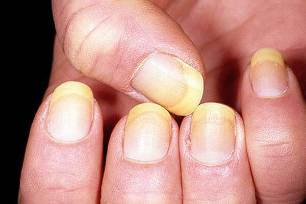
Treatment of psoriasis on the fingernails is similar to other treatments, but has its own characteristics. In the article, we will consider the symptoms, causes and also how to treat psoriasis of the toenails and nails.
Nail damage in psoriasis can occur under the influence of various reasons. Often this form is found in the context of a form of pathology such as psoriatic arthritis.
In medical practice, this type is called nail psoriasis or psoriatic onychodystrophy. It is quite rare, but it often presents with complications and many undesirable symptoms.
The following provoking factors can be attributed to the main causes of pathology:
- frequent stress and emotional stress;
- incorrect metabolic processes of the body;
- chronic infectious diseases;
- bad circulation;
- nail damage and exposure to certain chemicals;
- genetic predisposition.
Important! In some patients, nail psoriasis occurs against the background of damage to the nail plates from a bacterial infection. It is quite difficult to diagnose the disease in such cases; an experienced specialist must identify the disease.
Varieties
Psoriasis under the nails can develop in patients of different ages, but in most cases it occurs in patients older than 35-40 years. There are several forms of the disease. These include:
Thimble syndrome
This type is characterized by the defeat of the plate in the form of punctual notches. Most of the time, they are located in a certain area of the nail, but there are often cases where the grooves extend to the entire nail. Externally, the plate is similar to a thimble, which is why this type is often called a "thimble. "
Onycholysis
This shape has symptoms like dullness of the nail, loss of color. This happens due to the lack of healthy blood microcirculation. During the development of the disease, the plaque deforms and disappears. Only a small part of the plate remains on the base.
Start of bleeding
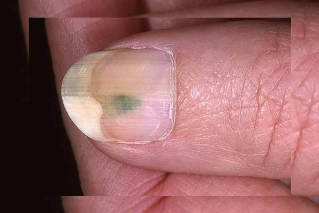
Involves the formation of red or pink spots under the nails. These symptoms appear at the beginning of the pathology. Also, signs such as bruising under the plaque may appear. There is also a compaction of the nail, its layers.
Psoriasis on the nails or fungi, how to distinguish them?
Often times, patients are interested in how to distinguish nail fungus from psoriasis. This problem is quite complicated and requires consultation with a specialist. Laboratory tests are also needed. Methods such as biopsy of dermis samples, as well as histological studies, help to exclude the fungus.
Differential diagnosis can be used to exclude diseases that also affect the nails. These include the following ailments:
- lichen planus;
- various forms of dermatosis;
- eczema.
The main indicator of psoriasis is also the absence of abnormalities in the composition of the blood. An increase in the level of leukocytes, as well as the erythrocyte sedimentation reaction, in most cases indicate the presence of infectious forms of pathology.
Important! The difference between nail fungus and nail psoriasis can only be detected with the help of laboratory tests. Outwardly, the pathologies can be almost the same.
The main manifestations of the disease
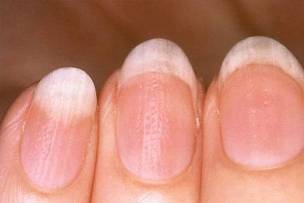
Fingernail psoriasis, like psoriasis on the feet, has many very unpleasant symptoms. Below you can see photos showing what psoriasis looks like on feet and nails. So, let's consider the manifestations of the disease, depending on its form.
Thimble psoriasis type has the following symptoms:
- appearance of furrows, depressions in the form of points;
- plate clouding;
- externally the plate bends and takes the shape of a hook;
- when pressing, pain is felt.
Onycholysis:
- changes the color of the plate;
- distortion of the nails, violation of their integrity;
- separate the plate from the body of the finger.
Bleeds:
- the appearance of red, brown and cyanotic spots under the nail;
- distortion of the shape of the plate, its cloudiness;
- hair damage;
- may have a purulent discharge when pressed.
Symptoms may vary slightly depending on the severity of the disease and the individual patient.
How to treat nail psoriasis
Is the question of how to treat nail psoriasis quite relevant today? In modern medical practice, there are many ways to treat disease. The main ones include:
- using external products.
- Take medications by mouth.
- Use of phototherapy and other physical treatments.
- The use of traditional medicine.
We propose to consider each of the methods in more detail below.
Treatment of nail psoriasis with creams and ointments
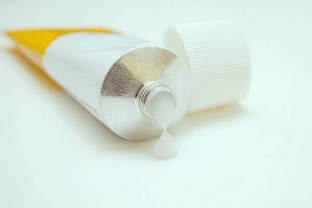
Nail psoriasis and its early medical treatment involves the use of topical agents.
Ointments can be hormonal or non-hormonal. The former are used for severe forms of the disease, in cases where non-hormonal drugs are ineffective.
Nail psoriasis ointment on the hands and feet may also be non-hormonal. These are drugs that include zinc, salicylic acid, etc.
Non-hormonal drugs have minimal side effects, they are not addictive, but their effect should wait a long time. Hormonal drugs work quickly, but they can cause many complications.
Oral drug use
The therapy of the disease must be comprehensive. The following remedies can also be used to eliminate symptoms and restore nails:
- Sedatives.
- Immunomodulators. Medications help improve a person's natural defenses.
- Anti-allergy medications.
Physiotherapy
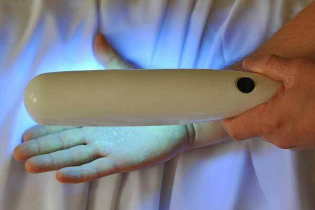
Recently, the use of physiotherapy methods has proven to be very good. Ultraviolet treatment, as well as the use of methods such as cryotherapy, azone therapy, treatment with an excimer laser, gives excellent results. The following types of physical treatment are most often used in medical practice:
- UV irradiation;
- PUVA therapy;
- X-ray therapy;
- use of ultrasound;
- laser treatment.
Important! The duration of the sessions and their number should be determined by an experienced specialist. Self-medication with these methods is strictly prohibited, as it often causes many side effects.
The role of traditional medicine
Home remedy treatment for nail psoriasis has long been used as a full-blown type of therapy. So how to cure nail psoriasis at home, we will find out below. There are many recipes to help cope with the symptoms of the pathology. The most popular medications include:
Decoction of celandine
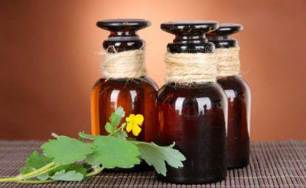
For 500 ml of water, 2 tablespoons. l. herbs. Bring the agent to a boil over low heat, cook for 30-40 minutes. The broth is used for baths, it is dissolved in water in a ratio of 1: 2, and the nails are soaked in it for 20-25 minutes.
Treatment of psoriasis on the nails with natural oils
Sea buckthorn oil eliminates inflammation very well. Softens the affected areas, enriches the nails with useful vitamins and minerals. To do this, using a cotton ball, the oil is applied to the plates and left for 30-40 minutes. The procedure is repeated 2-3 times a day.
Attention! If you decide to treat nail psoriasis on your own, consult a doctor before that, self-medication can harm your health!
Using the bow
Fresh onion is passed through a meat grinder, the resulting gruel is applied to the affected nails. I cover it with gauze and leave it for 30 minutes. The course of treatment lasts until a healthy nail grows back. Nail psoriasis is known as a serious chronic disease. It is very important to diagnose the disease in time and start the necessary treatment. This will help keep your hands and feet healthy and avoid many unpleasant complications.























